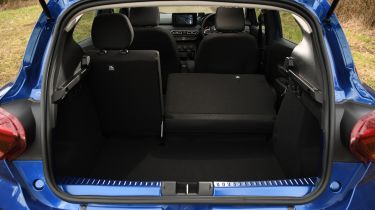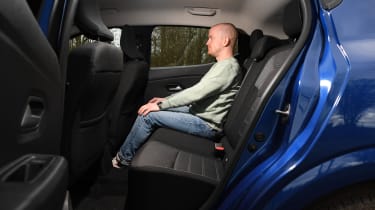Dacia Sandero - Practicality, comfort and boot space
The Dacia Sandero is a practical family option, offering decent boot space and plenty of room for passengers

If you have a city car budget, but need supermini space, then the Dacia Sandero could well be the answer to your motoring needs. There’s plenty of room up front, while passengers in the rear won’t feel short-changed as the latest model offers 42mm of extra leg room compared to its predecessor. Door bins feel a little flimsy, but are nicely shaped. The two cup holders between the front seats are very shallow, though.
The height and reach-adjustable steering wheel helps find a comfortable driving position, as does the height-adjustable driver’s seat. The central armrest that’s fixed to the seat of the mid-range expression can become irritating when in use because it gets in the way of the gearlever and handbrake. The priciest Journey and Extreme trims have an armrest integrated into the centre console, which is much better in terms of ergonomics.
All models also feature ISOFIX points for child seats and child locks for the rear doors, and there’s also an option to have a spare wheel in place of the standard tyre inflation kit.
Upgrading from Essential to Expression trim adds convenient features like keyless entry, automatic lights and wipers, cruise control, a reversing camera and rear parking sensors. The most expensive Journey and Extreme trims add front parking sensors.
Size
The Sandero measures 4,088mm in length, 1,848mm wide and stands 1,499mm tall. Its more SUV-like Sandero Stepway sibling is just 11mm longer and 36mm taller, but maintains the same width. By way of further comparison, a five-door Volkswagen Polo is a slightly smaller car all-round, with dimensions of 4,070mm (length), 1,751mm (width) and 1,451mm (height).
Leg room, head room & passenger space
There’s plenty of room for passengers in the rear seats of the latest Sandero, while head and legroom shouldn’t be an issue even for adult occupants. The doors open up wide which makes entry and egress easier, and will help when securing a child seat.
Used - available now

2024 Dacia
Sandero
30,015 milesManualPetrol1.0L
Cash £8,300
2019 Dacia
Sandero
31,433 milesManualPetrol1.0L
Cash £6,306
2022 Dacia
Sandero
16,031 milesManualPetrol-lpg1.0L
Cash £8,890
2022 Dacia
Sandero
23,083 milesManualPetrol1.0L
Cash £10,187We measured the rear seat area ourselves when we pitted the Dacia Sandero against its French rival, the Citroen C3, in our twin test. We found that the Sandero just about excelled in terms of knee, head, and elbow room, although not by an amount too noticeable to the naked eye.
|
Rear seat space comparison | |||
|
Knee room (min-max) |
Headroom |
Elbow room | |
|
Dacia Sandero |
600-820mm |
945mm |
1,414mm |
|
Citroen C3 |
580-815mm |
925mm |
1,395mm |
Boot
Boot capacity for the Sandero stands at 328 litres in this latest version, up from 320 litres before. That means it offers an extra 28 litres of cargo space compared to the Citroen C3, although the Sandero still lags behind the Renault Clio’s 391-litre boot. Folding down the 40:60 split rear seats leaves a noticeable step in the load space, but opens up a practical 1,108 litres of luggage space.
We found in our twin test between the Sandero and Citroen C3 that the Dacia’s boot is significantly longer than its rival. The lip height of both superminis was very similar though, and the Sandero’s boot was slightly narrower than the C3’s too.
|
Boot space comparison | |||
|
Length |
Width |
Lip height | |
|
Dacia Sandero |
805mm |
1,025mm |
755mm |
|
Citroen C3 |
677mm |
1,040mm |
765mm |
Towing
Whichever Sandero you choose, you'll have a maximum towing capacity of 1,100kg, which should be enough for most everyday needs.












